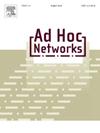数据驱动的无单元调度器
IF 4.4
3区 计算机科学
Q1 COMPUTER SCIENCE, INFORMATION SYSTEMS
引用次数: 0
摘要
在无蜂窝(CF)网络中,有效的调度是必不可少的,其中用户设备(ue)与多个分布式收发器(无线电单元(ru))通信,这些收发器连接到协调和处理接收或发送信号的集中式基站(BS)。与传统的蜂窝网络不同,CF网络没有蜂窝边界,允许ue无缝连接到多个ru,从而消除了收发器之间切换的传统必要性。在本文中,我们介绍了一种新的CF调度器,旨在提高数据服务质量(QoS)参数,包括吞吐量和延迟。调度程序采用神经网络(NN)算法,在分布式收发器网络上自主管理与用户的交互。该方法利用模型驱动和数据驱动两种方法来优化用户通信。为了减轻传统模型驱动算法的高计算复杂度,我们提出了一种从模型驱动方法中学习的监督神经网络。我们使用正交频分多址(OFDMA)波形在频率、时间、空间和极化(例如,资源块、OFDM符号、波束ID)方面的模拟数据,在多收发器RU环境中评估其性能。我们的研究结果表明,与穷举搜索方法相比,模型驱动算法表现出相当的性能,而监督神经网络在离线学习后表现出相当的效率。因此,我们的基于神经网络的调度程序成为优化CF网络调度的可行、有效的解决方案。本文章由计算机程序翻译,如有差异,请以英文原文为准。
Data-driven cell-free scheduler
Efficient scheduling is essential in cell-free (CF) networks, where user equipments (UEs) communicate with multiple distributed transceivers (radio units (RUs)) linked to a centralized base station (BS) that coordinates and processes the received or transmitted signals. Unlike traditional cellular networks, CF networks operate without cell boundaries, allowing UEs to seamlessly connect to multiple RUs, and thus eliminating the conventional necessity for handoffs between transceivers. In this paper, we introduce a novel CF scheduler designed to enhance data quality of service (QoS) parameters, including throughput, and latency. The scheduler employs a neural network (NN) algorithm to autonomously manage interactions with users across a distributed network of transceivers. This approach utilizes both model and data driven methods to optimize user communication. To mitigate the high computational complexity of traditional model-driven algorithms, we propose a supervised NN that learns from the model-driven approach. We assess its performance using simulated data from orthogonal frequency division multiple access (OFDMA) waveforms in frequency, time, space, and polarization (e.g., resource blocks, OFDM symbols, beam ID), within multi-transceiver RU environments. Our results indicate that the model-driven algorithms exhibit competitive performance compared to the exhaustive search method, while the supervised NN demonstrates comparable efficiency after offline learning. Consequently, our NN-based scheduler emerges as a viable, efficient solution for optimizing CF network scheduling.
求助全文
通过发布文献求助,成功后即可免费获取论文全文。
去求助
来源期刊

Ad Hoc Networks
工程技术-电信学
CiteScore
10.20
自引率
4.20%
发文量
131
审稿时长
4.8 months
期刊介绍:
The Ad Hoc Networks is an international and archival journal providing a publication vehicle for complete coverage of all topics of interest to those involved in ad hoc and sensor networking areas. The Ad Hoc Networks considers original, high quality and unpublished contributions addressing all aspects of ad hoc and sensor networks. Specific areas of interest include, but are not limited to:
Mobile and Wireless Ad Hoc Networks
Sensor Networks
Wireless Local and Personal Area Networks
Home Networks
Ad Hoc Networks of Autonomous Intelligent Systems
Novel Architectures for Ad Hoc and Sensor Networks
Self-organizing Network Architectures and Protocols
Transport Layer Protocols
Routing protocols (unicast, multicast, geocast, etc.)
Media Access Control Techniques
Error Control Schemes
Power-Aware, Low-Power and Energy-Efficient Designs
Synchronization and Scheduling Issues
Mobility Management
Mobility-Tolerant Communication Protocols
Location Tracking and Location-based Services
Resource and Information Management
Security and Fault-Tolerance Issues
Hardware and Software Platforms, Systems, and Testbeds
Experimental and Prototype Results
Quality-of-Service Issues
Cross-Layer Interactions
Scalability Issues
Performance Analysis and Simulation of Protocols.
 求助内容:
求助内容: 应助结果提醒方式:
应助结果提醒方式:


